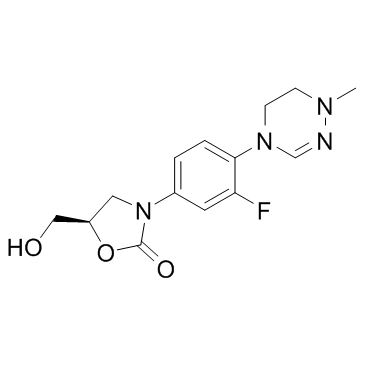All AbMole products are for research use only, cannot be used for human consumption.

In vitro: Delpazolid (LCB01-0371), at concentrations of 1×MIC and 2×MIC, has bacteriostatic activity against MSSA and MRSA after 24 h. At concentrations of 4×MIC and 8×MIC, Delpazolid shows bacteriostatic activity, but there is no regrowth at concentrations of 4×MIC and 8×MIC after 24 h of incubation. The survival of M. abscessus is greatly decreased in the presence of Delpazolid (LCB-0371) (MIC50=1.2 μg/mL). Delpazolid dramatically decreases the number of intracellular mycobacteria present at 2 days after infection at concentrations of 0.1, 1, and 10 μg/mL.
In vivo: When administered orally, Delpazolid (LCB01-0371) shows potent protective effects against systemic infections caused by Gram-positive and Gram-negative bacteria. Against infection caused by S. aureus Giorgio (MSSA), the ED50 of Delpazolid is 4.53 mg/kg of body weight. Against S. aureus p125 (MRSA), the ED50 of Delpazolid is 2.96 mg/kg. When Delpazolid (LCB-0371) is administered at 100 mg/kg daily (by gavage), the colony-forming unit (CFU) counts tend to be decreased in the lungs of mice at 7 days after infection.
| Cell Experiment | |
|---|---|
| Cell lines | |
| Preparation method | |
| Concentrations | |
| Incubation time | 2 days |
| Animal Experiment | |
|---|---|
| Animal models | WT mice |
| Formulation | PBS |
| Dosages | 2.96 mg/kg |
| Administration | oral |
| Molecular Weight | 308.31 |
| Formula | C14H17FN4O3 |
| CAS Number | 1219707-39-7 |
| Form | Solid |
| Solubility (25°C) | 30 mg/mL in DMSO |
| Storage |
Powder -20°C 3 years ; 4°C 2 years In solvent -80°C 6 months ; -20°C 1 month |
| Related Antibiotic Products |
|---|
| Puromycin-d3
Puromycin-d3 is the deuterium labeled Puromycin. Puromycin dihydrochloride is the dihydrochloride salt of puromycin. Puromycin is an aminoglycoside antibiotic that inhibits protein synthesis. |
| BSH-IN-1
BSH-IN-1 is a potent and covalent inhibitor of gut bacterial recombinant bile salt hydrolases (BSHs) with IC50s of 108 nM and 427 nM for B. longum BSH (Gram positive) and B. theta BSH (Gram negative), respectively. |
| AAA-10
AAA-10 is an orally active gut bacterial bile salt hydrolases (BSH) inhibitor, with IC50s of 10 nM, 80 nM against B. theta rBSH and B. longum rBSH respectively. |
| Gut restricted-7
Gut restricted-7 (GR-7) is a potent, covalent and orally active pan-bile salt hydrolase (BSH) inhibitor. Gut restricted-7 has a tissue-selective and is restricted to the gut. Gut restricted-7 decreases gut bacterial BSHs and decreases deconjugated bile acid levels in feces of mice. |
| N-Hydroxypipecolic acid
N-Hydroxypipecolic acid (1-Hydroxy-2-piperidinecarboxylic acid), a plant metabolite and a systemic acquired resistance (SAR) regulator, orchestrates SAR establishment in concert with the immune signal salicylic acid. N-Hydroxypipecolic acid accumulates systemically in the plant foliage in response to pathogen attack. N-Hydroxypipecolic acid induces SAR to bacterial and oomycete infection. |
All AbMole products are for research use only, cannot be used for human consumption or veterinary use. We do not provide products or services to individuals. Please comply with the intended use and do not use AbMole products for any other purpose.


Products are for research use only. Not for human use. We do not sell to patients.
© Copyright 2010-2024 AbMole BioScience. All Rights Reserved.
